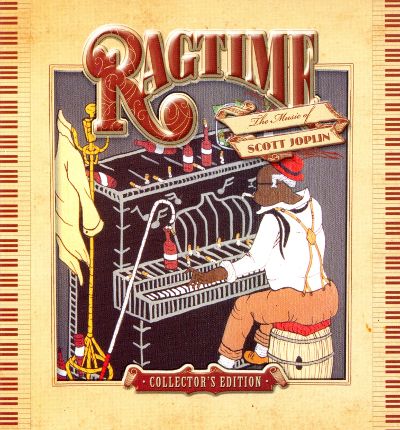By: Gabrielle Brim
Origins
Ragtime music originated during the late nineteenth century. It was created and popularized by wandering African American musicians who could not read or write music but relied on oral tradition. They established ragtime as a style of playing, and performed at bars and saloons after the Civil War.
Ragtime eventually became well-known due to the publishing of sheet music. Sheet music popularized ragtime throughout the United States and Europe. The sheet music contained titles, such as “Cakewalk,” “March,” “Two Step”, “Rag”, and images that illustrated the lyrics or characters within the text. Some images included the stereotypical images of African Americans with large lips eating watermelon or dancing.
Characteristics
Ragtime music has a performance style and consisted of cakewalks and coons songs, which were performed by whites in blackface and blacks in minstrel shows. The coon songs had fast, stereotypical lyrics and Negro dialect within them. In addition, the cakewalk was a dance that originated during slavery, in which slaves would imitate the behavior of upper-class whites. The dance contained male and female partners dressed up like the upper-class whites who walked in circles and strutted. In fact, there were contests held to see which slave couple had the best walk. In addition to its performance style, ragtime consisted of syncopation patterns that was upbeat and filled with several polyrhythms.
Important Performers
Some important performers of ragtime include Ben Harney and Scott Joplin. Harney was considered to be one of the first musicians that had published a ragtime composition. One of Harney’s songs called, “You’ve Been A Good Old Wagon but You’ve Done Broke Down,” which was published in 1895, represented early ragtime due to the rhythmic patterns and transition from oral tradition to printed music. In addition, Scott Joplin was a ragtime piano player that helped to establish standards and guidelines for playing ragtime. He was well-known for his sophisticated style in composition for classical ragtime, which was composed for pianos. Additionally, Joplin helped to develop other ragtime pianists by helping them publish their compositions.
[embedyt] https://www.youtube.com/watch?v=nhQvqK67Iwc[/embedyt]
Commodification
African American musicians did not publish as much due to the difficulty of receiving acknowledgement and payment from the publishing industry. However, most African American piano players played for tips at bars and saloons. Whites often transcribed what African American musicians played. As a result, whites commercialized the sheet music and the publishing industry expanded. However some artists, like Scott Joplin, received partial royalties, which are payments that music publishers give to composers based on the amount of copies that were sold. Unfortunately, artists did not receive royalties for all their compositions. On the other hand, musicians participated in ragtime cutting contests, which were held to determine the artist with the best creativity and skill.
Influences of Future Genres
Due to an abundance of sheet music for ragtime, the piano versions of ragtime music was incorporated in musical theater. In addition, during the early twentieth century, ragging became a compositional technique that was applied to classical music. Additionally, the instrumental ragtime music contained a march style with a 2/4 time signature that became part of the repertoire of instrumental ensembles and was found in early jazz.
Commentary
The syncopated and upbeat sounds of ragtime music reminds me of silent film movies and the Charlie Brown theme song. Although I am not familiar with the original sounds of ragtime music, I do notice how different composers “rag” or use the syncopation patterns found in ragtime music in other genres of music, such as classical music, jazz, and gospel. It is interesting how all these musical styles are transformed and reused throughout different time periods.


